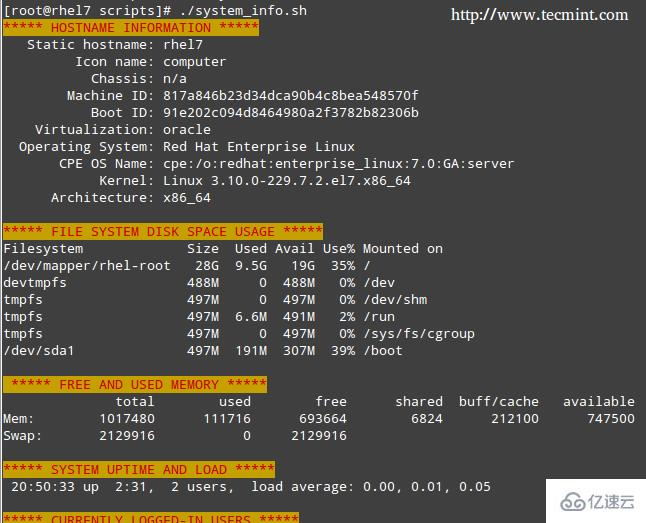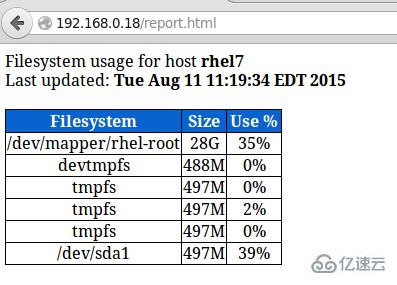这篇文章将为大家详细讲解有关如何使用Shell脚本自动化Linux系统维护任务,文章内容质量较高,因此小编分享给大家做个参考,希望大家阅读完这篇文章后对相关知识有一定的了解。
系统管理员通常会使用sehll脚本解决工作中重复的工作,shell脚本使系统管理员花费少的时间去做重复的工作。
什么是 shell 脚本?
简单的说,shell 脚本就是一个由 shell 一步一步执行的程序,而 shell 是在 Linux 内核和最终用户之间提供接口的另一个程序。
默认情况下,RHEL 7 中用户使用的 shell 是 bash(/bin/bash)。
写一个脚本显示系统信息
首先让我们新建一个目录用于保存我们的 shell 脚本:
# mkdir scripts
# cd scripts新建一个文本文件system_info.sh,在头部插入一些注释以及一些命令:
#!/bin/bash
# 该脚本会返回以下这些系统信息:
# -主机名称:
echo -e "\e[31;43m***** HOSTNAME INFORMATION *****\e[0m"
hostnamectl
echo ""
# -文件系统磁盘空间使用:
echo -e "\e[31;43m***** FILE SYSTEM DISK SPACE USAGE *****\e[0m"
df -h
echo ""
# -系统空闲和使用中的内存:
echo -e "\e[31;43m ***** FREE AND USED MEMORY *****\e[0m"
free
echo ""
# -系统启动时间:
echo -e "\e[31;43m***** SYSTEM UPTIME AND LOAD *****\e[0m"
uptime
echo ""
# -登录的用户:
echo -e "\e[31;43m***** CURRENTLY LOGGED-IN USERS *****\e[0m"
who
echo ""
# -使用内存最多的 5 个进程
echo -e "\e[31;43m***** TOP 5 MEMORY-CONSUMING PROCESSES *****\e[0m"
ps -eo %mem,%cpu,comm --sort=-%mem | head -n 6
echo ""
echo -e "\e[1;32mDone.\e[0m"然后,给脚本可执行权限,并运行脚本:
# chmod +x system_info.sh
./system_info.sh为了更好的可视化效果各部分标题都用颜色显示:
颜色功能是由以下命令提供的:
echo -e "\e[COLOR1;COLOR2m\e[0m"其中 COLOR1 和 COLOR2 是前景色和背景色,是你想用颜色显示的字符串。
使任务自动化
你想使其自动化的任务可能因情况而不同。因此,我们不可能在一篇文章中覆盖所有可能的场景,但是我们会介绍使用 shell 脚本可以使其自动化的三种典型任务:
1) 更新本地文件数据库
1) 查找(或者删除)有 777 权限的文件
2) 文件系统使用超过定义的阀值时发出警告。
让我们在脚本目录中新建一个名为 auto_tasks.sh 的文件并添加以下内容:
#!/bin/bash
# 自动化任务示例脚本:
# -更新本地文件数据库:
echo -e "\e[4;32mUPDATING LOCAL FILE DATABASE\e[0m"
updatedb
if [ $? == 0 ]; then
echo "The local file database was updated correctly."
else
echo "The local file database was not updated correctly."
fi
echo ""
# -查找 和/或 删除有 777 权限的文件。
echo -e "\e[4;32mLOOKING FOR FILES WITH 777 PERMISSIONS\e[0m"
# Enable either option (comment out the other line), but not both.
# Option 1: Delete files without prompting for confirmation. Assumes GNU version of find.
#find -type f -perm 0777 -delete
# Option 2: Ask for confirmation before deleting files. More portable across systems.
find -type f -perm 0777 -exec rm -i {} +;
echo ""
# -文件系统使用率超过定义的阀值时发出警告
echo -e "\e[4;32mCHECKING FILE SYSTEM USAGE\e[0m"
THRESHOLD=30
while read line; do
# This variable stores the file system path as a string
FILESYSTEM=$(echo $line | awk '{print $1}')
# This variable stores the use percentage (XX%)
PERCENTAGE=$(echo $line | awk '{print $5}')
# Use percentage without the % sign.
USAGE=${PERCENTAGE%?}
if [ $USAGE -gt $THRESHOLD ]; then
echo "The remaining available space in $FILESYSTEM is critically low. Used: $PERCENTAGE"
fi
done" >> $WEB_DIR/report.html # Read the output of df -h line by line while read line; do echo "" >> $WEB_DIR/report.html done " >> $WEB_DIR/report.html
在我们的 RHEL 7 服务器(192.168.0.18)中,看起来像下面这样:
你可以添加任何你想要的信息到那个报告中。添加下面的 crontab 条目在每天下午的 1:30 运行该脚本:
30 13 * * * /root/scripts/filesystem_usage.sh
关于如何使用Shell脚本自动化Linux系统维护任务就分享到这里了,希望以上内容可以对大家有一定的帮助,可以学到更多知识。如果觉得文章不错,可以把它分享出去让更多的人看到
亿速云「云服务器」,即开即用、新一代英特尔至强铂金CPU、三副本存储NVMe SSD云盘,价格低至29元/月。点击查看>>
免责声明:本站发布的内容(图片、视频和文字)以原创、转载和分享为主,文章观点不代表本网站立场,如果涉及侵权请联系站长邮箱:is@yisu.com进行举报,并提供相关证据,一经查实,将立刻删除涉嫌侵权内容。